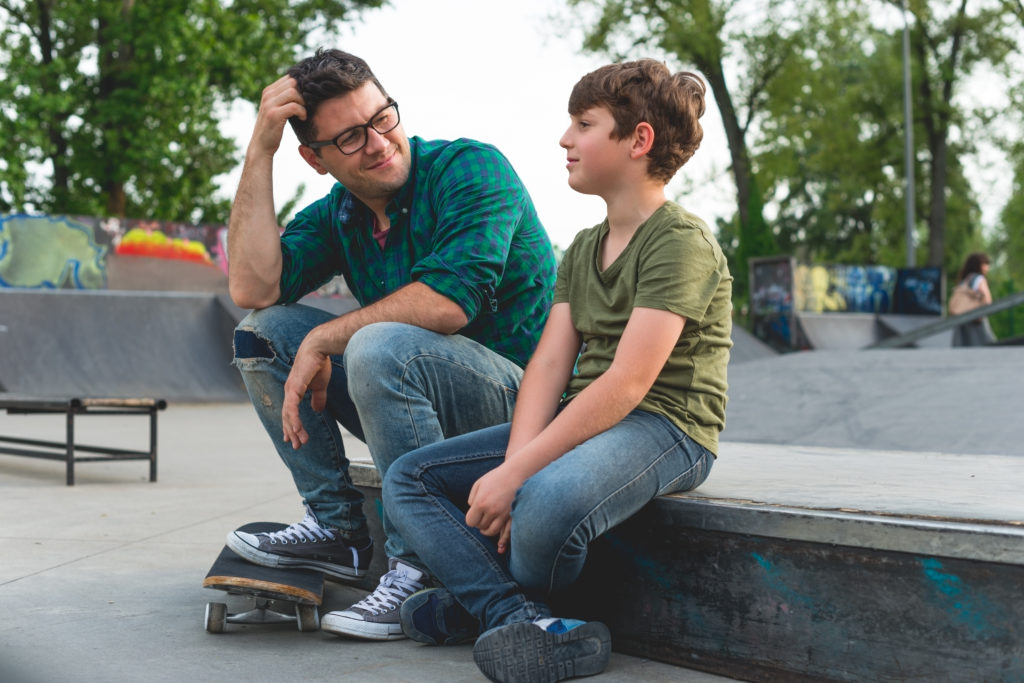
There is never the perfect time to talk to kids about the issues of abuse and assault, but there’s never been a more IMPORTANT time. It’s a tough discussion to start, but there are easy ways to start and build it into the conversations you are already having.
Parents.com highlights 3 tips for talking to your kids, stating “the terrifying, tragic truth is, you’re never too young to be affected by it [abuse/assault].”
1.Talk to boys as well as girls
“These issues don’t just come up for females, that’s something I want people to understand,” Karen Soren, MD, a professor of pediatrics at Columbia University Medical Center, told Parents.com. “We need to have these same conversations with our sons, not just with our daughters.”
– Parents.com, 2017
2. Make it age appropriate
For younger children, Parents.com states:
“While you should communicate this topic to young children, it’s important you consider your child’s age and capacity to comprehend such sensitive information when identifying how you’ll discuss it.”
RAINN (Rape, Abuse & Incest National Network) further outlines the following tips for conversations with your younger children — “Teach young children the language they need to talk about their bodies and information about boundaries to help them understand what is allowed and what is inappropriate.” Additionally, they suggest the following:
- Teach children the names of their body parts. When children have the words to describe their body parts, they may find it easier to ask questions and express concerns about those body parts.
- Some parts of the body are private. Let children know that other people shouldn’t touch or look at them. If a healthcare professional has to examine these parts of the body, be present.
- It’s OK to say “no.” It’s important to let children know they are allowed to say “no” to touches that make them uncomfortable. This message isn’t obvious to children, who are often taught to be obedient and follow the rules. Support your child if they say no, even if it puts you in an uncomfortable position. For example, if your child doesn’t want to hug someone at a family gathering, respect their decision to say “no” to this contact.
- Talk about secrets. Perpetrators will often use secret-keeping to manipulate children. Let children know they can always talk to you, especially if they’ve been told to keep a secret. If they see someone touching another child, they shouldn’t keep this secret, either. Learn more about protecting a child from sexual assault.
- Reassure them that they won’t get in trouble. Young children often fear getting in trouble or upsetting their parents by asking questions or talking about their experiences. Be a safe place for your child to share information about things that they have questions about or that make them uncomfortable. Remind them they won’t be punished for sharing this information with you.
- Show them what it looks like to do the right thing. It could be as simple as helping an elderly person get off a bus or picking up change that someone has dropped on the ground. When you model helping behavior it signals to your child that this is a normal, positive way to behave.
- When they come to you, make time for them. If your kid comes to you with something they feel is important, take the time to listen. Give them your undivided attention, and let them know you take their concerns seriously. They may be more likely to come to you in the future if they know their voice will be heard.
For your older kids/teens:
Parents.com suggests introducing the ideas of consent, voluntary activity, and peer pressure into the conversation.
RAINN further outlines some great tips for conversation starters:
- Use the media to make it relevant. Ask your teen’s opinion on something happening on social media, in the news, in a new movie, or on a popular TV show. You could even watch an episode with them and ask follow up questions. Asking their opinion shows them that you value their point of view and opens up the door for more conversation.
- Use your own experience to tell a safety story. Sharing your own experiences can make these conversations relevant and feel more real to teens. If you don’t have an experience you feel comfortable sharing, you can tell a story about someone you know.
- Talk about caring for their friends — not just about their own behavior.Talking about how to be a good friend can be a powerful way of expressing to your teen that you trust them to do the right thing without sounding like you’re targeting their personal behavior. It also gives you the chance to communicate safety practices they may not otherwise be receptive to.
- Talk about sexual assault directly. For some teens, safety issues like sexual assault aren’t on the radar. On the other hand, they may have misconceptions about sexual assault they’ve picked up from peers or the media. Bring up statistics that relate to them, such as the fact that 93 percent of victims who are minors know the perpetrator. Explain that no one “looks like a rapist,” and that seven out of 10 instances of sexual assault are committed by someone known to the victim.
3. Go with your gut
Ultimately, knowing your child and his or her capacity to internalize this sort of information is crucial when choosing how you approach this issue. “Everything depends on not just the age but the developmental stage,” Dr. Soren said.
– Parents.com, 2017
National statistics in your backyard:
More than 4,000 teens in Fond du Lac experience sexual or physical abuse or threats from a boyfriend or girlfriend in one year. *
17,024 Fond du Lac County women/girls will experience domestic violence, sexual assault, or stalking in their lifetime.**
Watch for teal tables — known as Project TableTalk — throughout the Fond du Lac area as a reminder of the urgency & importance of these conversations with our families, friends, coworkers and beyond. Additional literature and ideas for conversation starters can be found at those tables and on this community website — FDL Says No More.
*Based on national statistic applied to 2017 data from city of Fond du Lac schools.
** Based on national statistic applied to Fond du Lac County 2016 census data.
 Initiative of the
Initiative of the 

